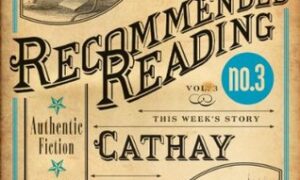 Tell the Story to Its End by Simon P. Clark
Tell the Story to Its End by Simon P. Clark
My rating: 3/5 cats



“In the end, time gets hold of everything. You know what an animal has to do, to get out of a trap? It has to wait. In the end, springs rust, bricks crumble, walls fall, and all you have to do, to escape any trap, is exist longer than it does.”
i didn’t know this was middle grade when i requested it from netgalley. in fact, i’m still not sure that it is.
the synopsis for this book says it is reminiscent of Skellig and A Monster Calls, and this is one of the few times where i absolutely agree with the comparisons. good readers’ advisory work, there! i would also compare it to The Nest, since i read it recently and it’s fresh in my mind. all of these books are about a young boy dealing with the pressures of the real world (usually a family member’s illness, but in this one it’s a little different), and the appearance of a supernatural entity who either tempts, or guides, or advises the boy – not always helpfully or in his best interest, with an ominous tone and some ambiguity over whether the apparition is real or just a coping mechanism.
oli and his mother have left london temporarily to live in the countryside with oli’s aunt and uncle, whom he has never met. oli’s father has stayed behind in london, but his mother assures him he is just finishing up some work, and will be joining them shortly, and that this is just a nice holiday for the two of them. however, oli senses there are things he is not being told. as time passes, he overhears whispered conversations and sees the pity (or contempt) in the eyes of neighbors, and he knows that there is more to the story.
oli makes friends with some of the local children; emma and takeru, but he also forms a relationship with eren; a creature who lives in his uncle’s attic – a giant batlike/spiderlike creature who feeds upon stories. and eren finds oli’s stories particularly compelling; particularly delicious.
the story flits back and forth between oli and his family and his new friends, as the truth about his father is slowly revealed, but it is also intercut with dreamlike sequences in which oli and eren interact and tell stories and truths. these meetings begin in the attic, but also cross over into oli’s dreams, and then into eren’s realm – somewhere in-between waking and sleep:“It’s more of a thought…than any room you would recognize.”.
eren only wants to talk about stories and the nature of storytelling – he tells his own allegorical tales and teaches oli about the potential powers of stories, and their purpose:
“Yarns and tales and the telling, they’re all about unravelling the truths that life hides, you ken? It’s about finding out, if a princess is locked in a tower, how would you get her down? It’s about you, and the story, and where the two things meet.”
but he expects reciprocity from oli.
“Telling them is kind of working against my nature. No matter, though. If you know how to tell ’em better after this, it’s all the same to me, eh?”
eren becomes increasingly demanding in his need for stories, and the novel becomes more ominous as fantastic elements invade oli’s waking day. eren grows stronger as oli grows weaker, losing his grip on reality while ironically coming ever-closer to getting to the heart of his father’s own story.
it’s a haunting novel, filled with all the feelings of helplessness and rage that come with the territory of being a little kid, and one where the fantastical fairy tales become more anchoring to oli than the secret-filled version of what had once been a stable life.
my confusion about the intended audience concerns the ending, and it mostly hinges on my complete ignorance of the intellectual development of children of the middle-grade age. (or younger. or older. or adults.) the ending of this book is fairly bleak and horrible. but it also uses that circular structure where the story opens with an “ending” that seems to occur after the actual ending that alleviates the bleakness somewhat. now, although this book is indeed preoccupied with storytelling and “endings” and the very ideas of shape and structure that this book employs, is this a device with which kids of the 8-12 age range are familiar? will they go back to the beginning to revisit that scene? or will they just read that ending and, i dunno, be distressed? do kids even read Finnegans Wake these days? it’s the ending that makes me question the MG-ness of this book. it has a few pictures, which makes me say “yes, perhaps middle grade,” and people on here have been deeming it such, but i’m a little concerned that kids are gonna read that ending and turn into tiny little nihilists. and we don’t need any more of those.
but i enjoyed it, even if i have some trepidation.
and it’s certainly got one good piece of cautionary advice:
“Know better, next time, apple-lord, before you meddle with a cat.”
NEVER meddle with cats.







